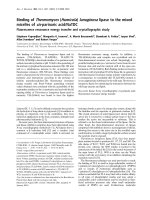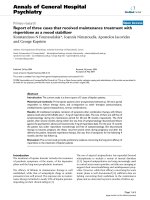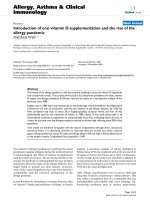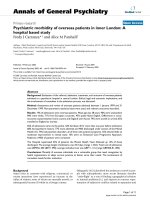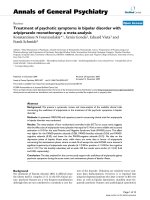Báo cáo y học: "Utilisation of podiatry services in Australia under the Medicare Enhanced Primary Care program, 2004-2008" pps
Bạn đang xem bản rút gọn của tài liệu. Xem và tải ngay bản đầy đủ của tài liệu tại đây (283.44 KB, 6 trang )
BioMed Central
Page 1 of 6
(page number not for citation purposes)
Journal of Foot and Ankle Research
Open Access
Research
Utilisation of podiatry services in Australia under the Medicare
Enhanced Primary Care program, 2004-2008
Hylton B Menz
Address: Musculoskeletal Research Centre, Faculty of Health Sciences, La Trobe University, Bundoora, Victoria 3086, Australia
Email: Hylton B Menz -
Abstract
Background: In 2004, as an extension of the Enhanced Primary Care (EPC) program, the
Australian Government introduced a policy of providing Medicare rebates for allied health services
provided to patients with chronic or complex health conditions. The objective of this study was to
evaluate the utilisation of podiatry services provided under this scheme between 2004 and 2008.
Methods: Data pertaining to the Medicare item 10962 for the calendar years 2004-2008 were
extracted from the Australian Medicare Benefits Schedule (MBS) database and cross-tabulated by
sex and age. Descriptive analyses were undertaken to assess sex and age differences in the number
of consultations provided and to assess for temporal trends over the five-year assessment period.
The total cost to Medicare over this period was also determined.
Results: During the 2004-2008 period, a total of 1,338,044 EPC consultations were provided by
podiatrists in Australia. Females exhibited higher utilisation than males (63 versus 37%), and those
aged over 65 years accounted for 75% of consultations. There was a marked increase in the number
of consultations provided from 2004 to 2008, and the total cost of providing EPC podiatry services
during this period was $62.9 M.
Conclusion: Podiatry services have been extensively utilised under the EPC program by primary
care patients, particularly older women, and the number of services provided has increased
dramatically between 2004 and 2008. Further research is required to determine whether the EPC
program enhances clinical outcomes compared to standard practice.
Background
Management of chronic disease accounts for a considera-
ble degree of healthcare expenditure in Australia, with
recent data indicating that chronic medical conditions are
responsible for more than 80% of the total burden of dis-
ease and injury [1]. In 1999, the Australian Government
introduced the Enhanced Primary Care (EPC) program to
improve the coordination of health care for people with
chronic and complex conditions [2]. As part of an exten-
sion and redevelopment of this scheme, chronic disease
management items were added to Medicare in 2004, ena-
bling rebates to be paid for individual services provided
by allied health professionals, including aboriginal health
worker services, audiology, mental health services, psy-
chology, occupational therapy, diabetes education, oste-
opathy, exercise physiology, speech pathology,
chiropractic, dietetics, physiotherapy and podiatry [3].
To be eligible for rebates, patients are required to have a
chronic medical condition present for at least six months
Published: 30 October 2009
Journal of Foot and Ankle Research 2009, 2:30 doi:10.1186/1757-1146-2-30
Received: 29 July 2009
Accepted: 30 October 2009
This article is available from: />© 2009 Menz; licensee BioMed Central Ltd.
This is an Open Access article distributed under the terms of the Creative Commons Attribution License ( />),
which permits unrestricted use, distribution, and reproduction in any medium, provided the original work is properly cited.
Journal of Foot and Ankle Research 2009, 2:30 />Page 2 of 6
(page number not for citation purposes)
(such as asthma, cancer, cardiovascular disease, diabetes,
mental disorders and arthritis or other musculoskeletal
condition), or have complex care needs (defined as
requiring ongoing care from their general practitioner
[GP] and at least two other health care providers). The
EPC chronic disease management program is coordinated
by the patient's GP, who prepares a management plan,
initiates the referrals to allied health professionals, and
reviews progress every six months. A maximum of five
allied health services is allowed per calendar year.
Although allied health practitioners can set their own fees,
each consultation attracts a maximum Medicare rebate of
$48.95 [4]. A schematic representation of the EPC pro-
gram (adapted from Foster et al [5]) is provided in Figure
1, and a full explanation of the program can be accessed
at the Medicare website [4].
In a recent critique of the EPC program, Foster et al [5]
highlighted the need for research to determine how
patients and allied health professionals are responding to
the initiative. Therefore, the aim of this study was to eval-
uate the utilisation of podiatry services under the EPC pro-
gram between 2004 and 2008, by extracting data from the
Medicare Benefits Schedule database [6]. Specifically, the
total number of podiatry services provided compared to
other allied health professions, sex and age differences in
the number of services provided, trends over time, and
total costs were explored.
Methods
Data extraction from the Medicare Benefits Schedule
database
Data pertaining to all allied health professional item
numbers under the EPC chronic disease management pro-
gram for the calendar years 2004-2008 were extracted
from the Medicare Benefits Schedule (MBS) database
(item numbers 10950-10970) [6]. The complete dataset
for item 10962 (consisting of the number of podiatry con-
sultations provided according to sex, age-group, calendar
year and state, along with matching cost data) was
extracted and exported into Microsoft Excel (Microsoft
Corp, Redmond USA) for analysis. To evaluate the trend
in the total number of consultations per year between
2004 and 2008, per capita figures were extracted, as the
number of people enrolled in Medicare each year varied
over the assessment period. To evaluate the number of
consultations provided in each state, both unadjusted and
adjusted figures were calculated. Adjustments were based
on state population data in the September 2008 quarter
provided by the Australian Bureau of Statistics [7].
Schematic representation of the EPC programFigure 1
Schematic representation of the EPC program. Note that the system is not a GP fundholder model - the podiatrist is
paid by the patient at the time of consultation and the patient is subsequently reimbursed by Medicare.
General practitioner (GP)
Podiatrist
GP Management Plan (GPMP)
Item 721
Medicare fee = $124.95
+
Team Care Arrangements (TCAs)
Item 723
Medicare fee = $98.95
Review of GPMP
Item 725
Medicare fee = $62.50
Review of TCA
Item 727
Once every 6 months
Medicare fee = $62.50
Referral
May require initial consultation
about TCA
No rebate
Provision of service
Item 10962
Maximum of 5 per year
(may be shared between two
allied health providers)
Rebate = $48.95
Written report to GP on first
and last visit if providing
multiple services, otherwise
after each service
No rebate
May contribute to TCA review
No rebate
Journal of Foot and Ankle Research 2009, 2:30 />Page 3 of 6
(page number not for citation purposes)
Statistical analysis
Data were analysed using simple descriptive statistics
(total number of consultations cross-tabulated by sex,
age-group, calendar year and state), as the publicly acces-
sible version of the MBS database does not allow for the
extraction of individual-level data.
Results
Total number of consultations provided
The total number of EPC consultations provided for each
of the allied health professions between 2004 and 2008 is
shown in Figure 2. A total of 1,338,044 EPC services were
provided by podiatrists, second only to physiotherapy
(1,388,460 services). Podiatry services accounted for 34%
of all EPC consultations provided by allied health profes-
sionals.
Service provision by state
The total number of EPC podiatry consultations by state is
shown in Figure 3. The highest proportion was provided
in New South Wales (494,420, or 37%). However, when
expressed relative to population, South Australia exhib-
ited the highest proportion of EPC podiatry consultations
(83 per 1,000 population).
Service provision by sex and age
The total number of EPC podiatry consultations provided
according to sex and age is shown in Figure 4. Females
exhibited higher utilisation than males (63 versus 37%),
and those aged over 65 years accounted for 75% of all
consultations provided.
Changes over time
The number of EPC podiatry consultations provided
between 2004 and 2008 is shown in Figure 5, expressed as
the total number of consultations and the number of con-
sultations per 100,000 people enrolled in Medicare, as
enrolment numbers fluctuate from year to year with births
and deaths. There was a marked increase in the number of
consultations over the five-year assessment period, both
in absolute terms and relative to the number of people
enrolled in Medicare.
Costs
The total cost of subsidising EPC podiatry consultations
per year over the 2004-2008 period is shown in Figure 6.
Over the five-year assessment period, the total cost was
$62,888,196. This figure is slightly less than the number
of consultations would indicate (which would be
expected to be $65,497,254, i.e. the total number of con-
sultations multiplied by $48.95), as cost data lags behind
consultation data on the MBS database.
Discussion
The objective of this study was to provide a basic descrip-
tive analysis of podiatry services provided under the Aus-
tralian Government's Enhanced Primary Care (EPC)
chronic disease management program between 2004 and
2008. During this period, the analysis indicates that over
1.3 million EPC services were provided by podiatrists in
Total number of EPC consultations between 2004 and 2008 for each allied health professionFigure 2
Total number of EPC consultations between 2004
and 2008 for each allied health profession.
SK\VLRWKHUDS\
SRGLDWU\
GLHWHWLFV
FKLURSUDFWLF
VSHHFKSDWKRORJ\
SV\FKRORJ\
H[HUFLVHSK\VLRORJ\
RVWHRSDWK\
GLDEHWHVHGXFDWLRQ
RFFXSDWLRQDOWKHUDS\
PHQWDOKHDOWK
DXGLRORJ\
DERULJLQDOKHDOWKZRUNHU
QXPEHURIVHUYLFHVV
Total (a) and per capita (b) podiatry EPC consultations between 2004 and 2008 by stateFigure 3
Total (a) and per capita (b) podiatry EPC consulta-
tions between 2004 and 2008 by state.
$
1HZ6RXWK:DOHV
9LFWRULD
4XHHQVODQG
6RXWK$XVWUDOLD
:HVWHUQ$XVWUDOLD
7DVPDQL D
$XVWUDOLDQ&DSLWDO7HUULWRU\
1RUWKHUQ7HUULWRU\
VHUYLFHVV
%
1HZ6RXWK:DOHV
9LFWRULD
4XHHQVODQG
6RXWK$XVWUDOLD
:HVWHUQ$XVWUDOLD
7DV P DQLD
$XVWUDOLDQ&DSLWDO7HUULWRU\
1RUWKHUQ7HUULWRU\
VHUYLFHVSHUSRSXODWLRQ
Journal of Foot and Ankle Research 2009, 2:30 />Page 4 of 6
(page number not for citation purposes)
Australia, which accounts for approximately one-third of
the total number of allied health services provided by the
program. This level of utilisation of podiatry services is
striking when viewed in the context of the size of the podi-
atry labour force. The most recent labour force statistics
estimate that in 2003, there were 1,820 practicing podia-
trists in Australia - an extremely small number compared
to other allied health professions such as physiotherapy
(14,300), psychology (13,939) and occupational therapy
(3,107) [8-11].
Utilisation of podiatry services was higher in women than
men, and those aged over 65 years accounted for 75% of
all services provided. The over-representation of women
and those aged over 65 was expected, given that female
sex [12-17] and age [12,16-19] are well-established risk
factors for the development of foot problems. Further-
more, the findings are consistent with a recent South Aus-
tralian study which reported that people who accessed
podiatry services were more likely to be older, female, and
have chronic conditions (such as obesity, osteoporosis,
osteoarthritis, diabetes, cardiovascular disease and high
blood pressure) [20]. Based on these findings, it would
appear that EPC podiatry services are being accessed by
population groups who have the greatest need for them.
Although the total number of consultations in each state
was a simple reflection of population size, there was con-
siderable variation when consultations in each state were
expressed per capita, with South Australia having the
highest rate of consultation (83 per 1,000 population).
Several factors could be responsible for this variation
between states, including population demographics (such
as age and ethnicity) and socio-economic characteristics.
It is interesting to note, however, that the per capita values
are broadly reflective of each state's podiatry labour force.
In 2003 (the most recent labour force data available), the
number of full-time equivalent podiatrists per 100,000
population was as follows: South Australia - 17.4, Victoria
- 13.0, Tasmania - 12.4, New South Wales: 9.3, and
Queensland - 7.7 [8]. Although the public sector would
absorb some of the demand for podiatry services, in most
states over 75% of podiatrists work in the private sector.
This suggests that the availability of private podiatry serv-
ices in each state may play a role in determining the total
number of consultations covered under the EPC scheme.
If so, this may have equity implications for people in need
of podiatry services residing in states with fewer podia-
trists.
Number of EPC podiatry consultations between 2004 and 2008, expressed as the total number of services and the number of services per 100,000 people enrolled in MedicareFigure 5
Number of EPC podiatry consultations between 2004
and 2008, expressed as the total number of services
and the number of services per 100,000 people
enrolled in Medicare.
\HDU
WRWDO(3&LWHPV
(3&LWHPVSHUHQUROOHGLQ
0HGLFDUH
WRWDO
SHUFDSLWD
Cost of subsidising EPC podiatry consultations per year between 2004 and 2008Figure 6
Cost of subsidising EPC podiatry consultations per
year between 2004 and 2008.
\HDU
FRVWVV
Number of EPC podiatry consultations between 2004 and 2008 by sex and ageFigure 4
Number of EPC podiatry consultations between 2004
and 2008 by sex and age.
DJHJURXS\HDUV
QXPEHURIFRQVXOWDWLRQV
IHPDOH
PDOH
WRWDO
Journal of Foot and Ankle Research 2009, 2:30 />Page 5 of 6
(page number not for citation purposes)
Between 2004 and 2008, there was a marked increase in
the number of podiatry services provided under the EPC
program, which reflects the overall trend in utilisation of
the program by general practitioners and allied health
professionals. The costs associated with the program have
been substantial, with $62.9 M of government funding
allocated for EPC podiatry rebates. However, it remains to
be seen whether the present high growth in utilisation of
EPC services is sustainable. Initial government estimates
predicted a total cost of $247 M over the first four years
[21]. However, over the 2004-2008 period, over six mil-
lion rebates were provided, at a total cost of approxi-
mately half a billion dollars [6]. Although there have been
anecdotal reports of inappropriate use of the program
(including a $300 care plan involving a dietician and
endocrinologist for a woman only 5 kg overweight [21]),
no systematic audits of the EPC program have so far been
conducted, although there are plans to do so.
Despite the apparent popularity of the EPC program with
both health care providers and patients, several authors
have expressed concerns regarding both its implementa-
tion and efficacy [5,22-25]. Focus group studies have indi-
cated that many GPs consider the paperwork associated
with the program to be excessive [26,27], and many
believe the case conferencing item to be essentially impos-
sible to implement [28]. Almost twice as many patients
are being managed under GP management plans com-
pared to team care arrangements, and it has been esti-
mated that covering the cost of GP management plans
accounts for approximately half of the cost of the entire
program. Furthermore, an analysis of MBS data for 2007-
2008 indicated that only a small proportion of patients on
GP management plans were referred on for allied health
services, and less than half of all GP management plans
and only one-third of team care arrangements had been
reviewed [22,24].
From the allied health professional's perspective, con-
cerns have been raised that the care provided under the
EPC program may be sub-optimal, as the number of
funded treatments is often far less than what would nor-
mally be indicated in standard clinical practice [5]. The
lack of remuneration of allied health professionals for
non-treatment aspects of chronic disease management
(such as report-writing and telephone contact with the
GP) may also be significant disincentives to partake in the
program [5,29]. Estimates from 2006 revealed that the
average out-of-pocket expense for patients receiving an
allied health service was $14 [22], which suggests that
many allied health professionals, including podiatrists,
are charging above the maximum rebate of $48.95 to
cover their costs [30]. Given the relatively high overheads
associated with podiatry service provision compared to
other allied health services (due to factors such as the cost
of consumables and instrument sterilisation), there is a
sound argument for developing profession-specific
rebates rather than a "one size fits all" fee schedule.
A modification to the EPC scheme to simplify allied
health arrangements was announced by the health minis-
ter in January 2009, which specified that it is no longer
necessary for a care planning item to have been claimed
by the GP before allied health services can be provided
[31]. This addressed the problem of allied health claims
being rejected due to the GP plan having not yet been
processed, despite the patient having a valid referral. The
role of the GP as the "gate-keeper", however, is likely to
remain a key feature of the program [31]. Whether this is
the most appropriate model of service delivery is debatea-
ble. It could be reasonably argued that some of the fund-
ing currently allocated to cover GP management plans
could be better utilised by funding more podiatry consul-
tations under the EPC program, or by increasing funding
for podiatry services in the public sector.
The data presented here need to be considered in the con-
text of the inherent limitations of the MBS database. The
database collates the number of consultations provided,
rather than the number of individuals accessing allied
health services, and as such, no accurate individual-level
information can be extracted. Given that each patient is
eligible for up to five allied health consultations per year,
the actual number of individuals accessing podiatry serv-
ices under the scheme during, for example, the 2008 cal-
endar year, could be as low as 122,165 (i.e. the total
number of consultations in that year divided by five), or
as high as 610,829 (i.e. the total number of consultations
in that year, assuming one consultation per patient). The
actual number of patients accessing podiatry is likely to be
somewhere in the middle of these lower and upper limits,
but this cannot be accurately determined from the data-
base. For the same reason, age and sex cross-tabulations
may not provide an accurate estimate of the demograph-
ics of those accessing podiatry, as it is likely that older
women are not only over-represented as patients, but also
in terms of the number of consultations (i.e. older women
may be more likely to be referred for, and "use up", all five
of the allowable consultations than other population
groups). Finally, the database does not collect informa-
tion on the specific treatments provided during the con-
sultation or comorbidities of those receiving podiatry
services. While it is likely that a large proportion of con-
sultations would involve general maintenance of nail and
skin disorders and provision of foot care/footwear advice
in people with diabetes, access to individual patient
records would be required to confirm this.
Despite the inherent limitations of the MBS database, the
data presented here clearly show that podiatry is a very sig-
Publish with Bio Med Central and every
scientist can read your work free of charge
"BioMed Central will be the most significant development for
disseminating the results of biomedical research in our lifetime."
Sir Paul Nurse, Cancer Research UK
Your research papers will be:
available free of charge to the entire biomedical community
peer reviewed and published immediately upon acceptance
cited in PubMed and archived on PubMed Central
yours — you keep the copyright
Submit your manuscript here:
/>BioMedcentral
Journal of Foot and Ankle Research 2009, 2:30 />Page 6 of 6
(page number not for citation purposes)
nificant component of the EPC program, and that subsi-
dising podiatry services represents a major funding
commitment by the Commonwealth government. Fur-
ther research is required to assess whether the program
improves health outcomes compared to standard clinical
practice, and whether modifications to the scheme can
improve accessibility, efficiency and cost-effectiveness.
Conclusion
This analysis of the MBS database indicates that podiatry
services have been extensively utilised under the EPC pro-
gram by primary care patients, particularly older women.
The number of podiatry services provided has increased
dramatically between 2004 and 2008, which mirrors the
escalating uptake of the program in general. Further
research is required to determine whether the EPC pro-
gram enhances clinical outcomes compared to standard
practice, and whether modifications to the policy can
improve the administration of the program.
Competing interests
HBM is Editor-in-Chief of the Journal of Foot and Ankle
Research. It is journal policy that editors are removed from
the peer review and editorial decision making processes
for papers they have authored or co-authored.
Acknowledgements
HBM is currently a National Health and Medical Research Council fellow
(Clinical Career Development Award, ID: 433049). The author would like
to thank Dr Shannon Munteanu for helpful comments on the manuscript.
References
1. Australian Institute of Health and Welfare: Chronic disease and associ-
ated risk factors in Australia (AIHW cat no. PHE 81). Canberra 2006.
2. New Medicare rebate to encourage expansion of GP Care
[ />health-mediarel-yr1999-mw-mw99105.htm]
3. Expanded Medicare services for the chronically ill [http://
www.health.gov.au/internet/ministers/publishing.nsf/Content/health-
mediarel-yr2004-ta-abb092.htm]
4. Allied Health Services Under Medicare - Fact Sheet [http://
www.health.gov.au/internet/main/publishing.nsf/Content/health-
medicare-health_pro-gp-pdf-allied-cnt.htm]
5. Foster MM, Mitchell G, Haines T, Tweedy S, Cornwell P, Fleming J:
Does Enhanced Primary Care enhance primary care? Policy-
induced dilemmas for allied health professionals. Med J Aust
2008, 188:29-32.
6. Medicare Benefits Schedule database [icar
eaustralia.gov.au/provider/medicare/mbs.shtml]
7. Australian Bureau of Statistics: Australian Demographic Statistics, Sep
2008 (3101.0) Canberra: Australian Bureau of Statistics; 2009.
8. Australian Institute of Health and Welfare: Podiatry Labour Force 2003
Canberra: Australian Institute of Health and Welfare; 2006.
9. Australian Institute of Health and Welfare: Physiotherapy Labour Force
2002 Canberra: Australian Institute of Health and Welfare; 2006.
10. Australian Institute of Health and Welfare: Psychology Labour Force
2003 Canberra: Australian Institute of Health and Welfare; 2006.
11. Australian Institute of Health and Welfare: Occupational Therapy
Labour Force 2002-2003 Canberra: Australian Institute of Health and
Welfare; 2006.
12. Garrow AP, Silman AJ, Macfarlane GJ: The Cheshire Foot Pain
and Disability Survey: a population survey assessing preva-
lence and associations. Pain 2004, 110:378-384.
13. Benvenuti F, Ferrucci L, Guralnik JM, Gangemi S, Baroni A: Foot pain
and disability in older persons: an epidemiologic survey. J Am
Geriatr Soc 1995, 43:479-484.
14. Gorter KJ, Kuyvenhoven MM, deMelker RA: Nontraumatic foot
complaints in older people. A population-based survey of
risk factors, mobility, and well-being. J Am Podiatr Med Assoc
2000, 90:397-402.
15. Menz HB, Morris ME: Determinants of disabling foot pain in
retirement village residents. J Am Podiatr Med Assoc 2005,
95:573-579.
16. Hill CL, Gill T, Menz HB, Taylor AW: Prevalence and correlates
of foot pain in a population-based study: the North West
Adelaide Health Study. J Foot Ankle Res 2008, 1:1.
17. Farndon L, Barnes A, Littlewood K, Harle J, Beecroft C, Burnside J,
Wheeler T, Morris S, Walters SJ: Clinical audit of core podiatry
treatment in the NHS. J Foot Ankle Res 2009, 2:7.
18. Brodie BS, Rees CL, Robins DJ, Wilson AFJ: Wessex Feet: a
regional foot health survey, Volume I: The survey. Chiropodist
1988, 43:152-165.
19. Greenberg L, Davis H: Foot problems in the US. The 1990
National Health Interview Survey. J Am Podiatr Med Assoc 1993,
83:
475-483.
20. Menz HB, Gill TK, Taylor AW, Hill CL: Predictors of podiatry uti-
lisation in Australia: the North West Adelaide Health Study.
J Foot Ankle Res 2008, 1:8.
21. Anastopoulos C: Chronic disease items blow budget. Australian
Doctor 2006.
22. Russell LM: A primary care reform agenda for Australia Sydney: Menzies
Centre for Health Policy; 2008.
23. Swerissen H, Taylor MJ: Reforming funding for chronic illness:
Medicare-CDM. Aust Health Rev 2008, 32:76-84.
24. Russell L: Reform must improve quality of life The Australian; 2009.
25. Hartigan PA, Soo TM, Kljakovic M: Do team care arrangements
address the real issues in the management of chronic dis-
ease? Med J Aust 2009, 191:99-100.
26. Wilkinson D, McElroy H, Beilby J, Mott K, Price K, Morey S, Best J:
Uptake of health assessments, care plans and case confer-
ences by general practitioners through the Enhanced Pri-
mary Care program between November 1999 and October
2001. Aust Health Rev 2002, 25:1-11.
27. Oldroyd J, Proudfoot J, Infante FA, Davies GP, Bubner T, Holton C,
Beilby JJ, Harris MF: Providing healthcare for people with
chronic illness: the views of Australian GPs. Med J Aust 2003,
179:30-33.
28. Mitchell GK, DeJong IC, DelMar CB, Clavarino AM, Kennedy R: Gen-
eral practitioner attitudes to case conferences: how can we
increase participation and effectiveness? Med J Aust 2002,
177:95-97.
29. Lewis P, White A, Misan G, Harvey P, Connolly J, Noone J:
Enhanced primary care. A rural perspective. Aust Fam Physician
2003, 32:186-188.
30. Do you bulk-bill on podiatry Medicare items? [http://
www.podiatry-arena.com/podiatry-forum/showthread.php?t=1442]
31. Enhanced Primary Care Program (EPC): simpler adminis-
trative arrangements for allied health [http://
www.health.gov.au/internet/main/publishing.nsf/Content/admin-
arrangement-for-allied-health]

